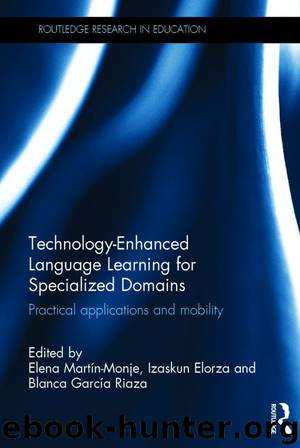Technology-Enhanced Language Learning for Specialized Domains (Routledge Research in Education) by Elena Martín-Monje

Author:Elena Martín-Monje [Elena Martín-Monje]
Language: eng
Format: epub
Publisher: Swales and Willis
Published: 2016-03-09T16:00:00+00:00
Issues of concern
There are a number of caveats connected to this research project, which need to be borne in mind when assessing the results.
As noted earlier, this research study was very small and carried out with only two groups of EFL students, with class sizes of 12 and eight students. In addition, I was only able to work for one week with each group for a total of 15 hours. It is unlikely that the use of mobile devices in and/or out of class continued to occur in their learning, as other teachers in the institution were not part of this project. The rapid turnover of learners and regularly changing teachers typical of the context of a UK language school in summer meant that working with a number of teachers on a longer-term project exploring the ongoing implementation of mobile devices, was simply not possible.
In addition, working with an international group of adult learners (aged 16+) in a multilingual context is in many ways atypical of much EFL teaching around the world, which tends to take place in monolingual contexts. The multilingual context of the study meant that interesting challenges arose – such as a reluctance to take part in communicative tasks and the related need for learner training. Although such obstacles affected only one student, it does highlight the importance of the educational/learning context when it comes to implementing certain types of tasks and approaches. Working with monolingual groups in a number of different contexts would allow for more context-specific decisions to be made about mobile task design, and especially sequencing.
Furthermore, in this particular study, given the low language proficiency of both groups, it was difficult to solicit detailed feedback from the learners about their experiences, in English. When the researcher speaks the L1 (first language) in a monolingual context, learners with low proficiency in English can provide much more complex and nuanced reactions to the use of mobile devices, as they are able to express themselves in their L1s.
But perhaps most importantly, a major drawback of this study was its ad hoc nature. If the use of mobile devices is to be well integrated into learning, and if students are to fully reap the benefits, there needs to be institutional support. A teacher’s work in the classroom should form part of a wider mobile strategy as part of an institution’s educational plan. More rigorous and longitudinal research can then be carried out in this particular context over time, and the learners’ experiences of mobile device use is less disjointed. However, it is hoped that this study – with its limitations kept firmly in mind – has helped foreground some of the key parameters involved in designing and sequencing classroom-based communicative tasks for mobile and handheld devices .
Download
This site does not store any files on its server. We only index and link to content provided by other sites. Please contact the content providers to delete copyright contents if any and email us, we'll remove relevant links or contents immediately.
The Art of Coaching Workbook by Elena Aguilar(50989)
Trainspotting by Irvine Welsh(21519)
Twilight of the Idols With the Antichrist and Ecce Homo by Friedrich Nietzsche(18503)
Fangirl by Rainbow Rowell(9096)
Periodization Training for Sports by Tudor Bompa(8170)
Change Your Questions, Change Your Life by Marilee Adams(7635)
This Is How You Lose Her by Junot Diaz(6794)
Asking the Right Questions: A Guide to Critical Thinking by M. Neil Browne & Stuart M. Keeley(5635)
Grit by Angela Duckworth(5523)
Red Sparrow by Jason Matthews(5390)
Paper Towns by Green John(5089)
Room 212 by Kate Stewart(5037)
Ken Follett - World without end by Ken Follett(4645)
Housekeeping by Marilynne Robinson(4347)
The Sports Rules Book by Human Kinetics(4294)
Double Down (Diary of a Wimpy Kid Book 11) by Jeff Kinney(4207)
Papillon (English) by Henri Charrière(4195)
The Motorcycle Diaries by Ernesto Che Guevara(4012)
Exercise Technique Manual for Resistance Training by National Strength & Conditioning Association(3956)
